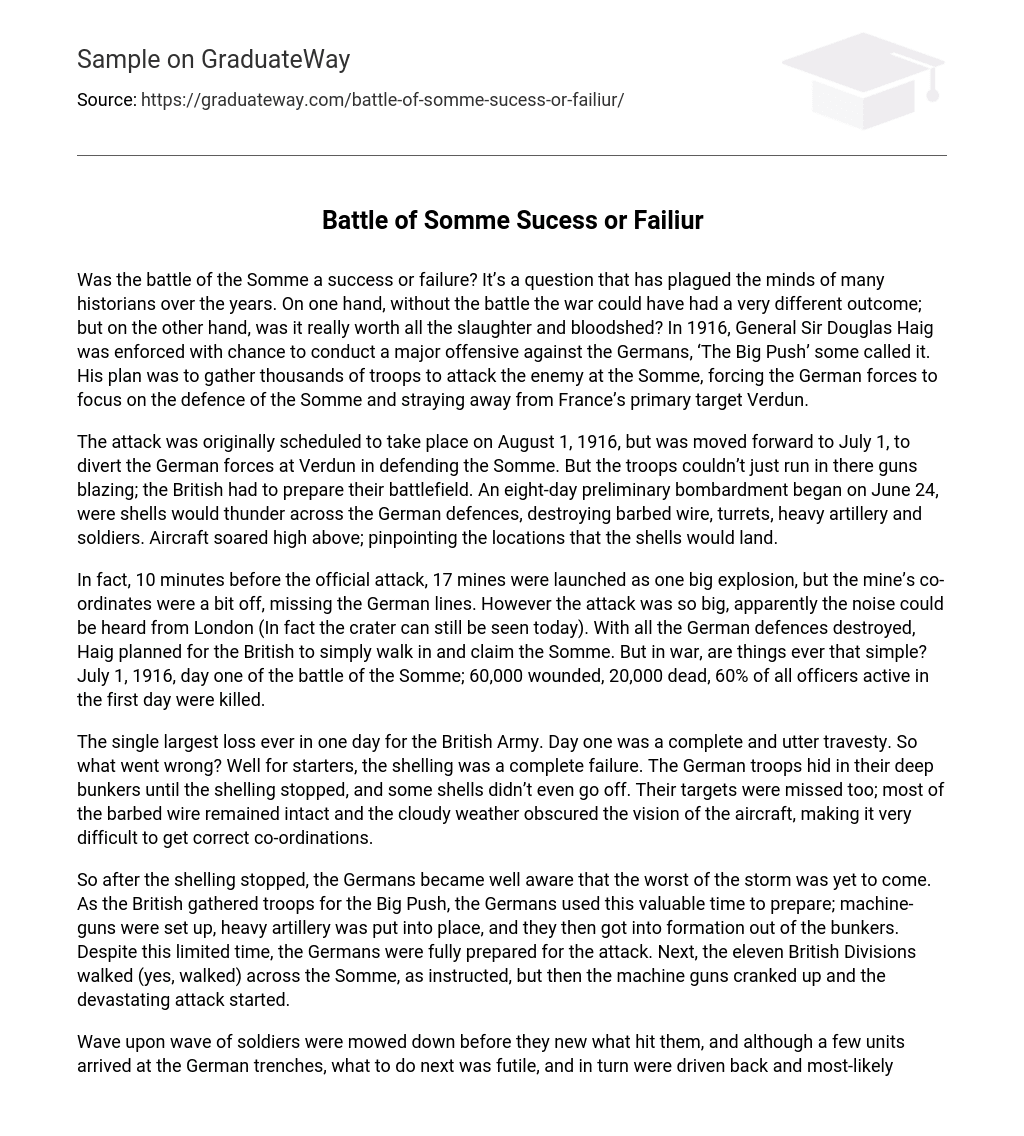Was the battle of the Somme a success or failure? It’s a question that has plagued the minds of many historians over the years. On one hand, without the battle the war could have had a very different outcome; but on the other hand, was it really worth all the slaughter and bloodshed? In 1916, General Sir Douglas Haig was enforced with chance to conduct a major offensive against the Germans, ‘The Big Push’ some called it. His plan was to gather thousands of troops to attack the enemy at the Somme, forcing the German forces to focus on the defence of the Somme and straying away from France’s primary target Verdun.
The attack was originally scheduled to take place on August 1, 1916, but was moved forward to July 1, to divert the German forces at Verdun in defending the Somme. But the troops couldn’t just run in there guns blazing; the British had to prepare their battlefield. An eight-day preliminary bombardment began on June 24, were shells would thunder across the German defences, destroying barbed wire, turrets, heavy artillery and soldiers. Aircraft soared high above; pinpointing the locations that the shells would land.
In fact, 10 minutes before the official attack, 17 mines were launched as one big explosion, but the mine’s co-ordinates were a bit off, missing the German lines. However the attack was so big, apparently the noise could be heard from London (In fact the crater can still be seen today). With all the German defences destroyed, Haig planned for the British to simply walk in and claim the Somme. But in war, are things ever that simple? July 1, 1916, day one of the battle of the Somme; 60,000 wounded, 20,000 dead, 60% of all officers active in the first day were killed.
The single largest loss ever in one day for the British Army. Day one was a complete and utter travesty. So what went wrong? Well for starters, the shelling was a complete failure. The German troops hid in their deep bunkers until the shelling stopped, and some shells didn’t even go off. Their targets were missed too; most of the barbed wire remained intact and the cloudy weather obscured the vision of the aircraft, making it very difficult to get correct co-ordinations.
So after the shelling stopped, the Germans became well aware that the worst of the storm was yet to come. As the British gathered troops for the Big Push, the Germans used this valuable time to prepare; machine-guns were set up, heavy artillery was put into place, and they then got into formation out of the bunkers. Despite this limited time, the Germans were fully prepared for the attack. Next, the eleven British Divisions walked (yes, walked) across the Somme, as instructed, but then the machine guns cranked up and the devastating attack started.
Wave upon wave of soldiers were mowed down before they new what hit them, and although a few units arrived at the German trenches, what to do next was futile, and in turn were driven back and most-likely killed. Britain’s ‘Pal’ battalions, who enlisted from the same towns and served together, suffered greatly. Entire battalions were wiped out instantly, and more followed over the coming weeks. Local newspapers would be filled with lists of the dead, wounded and missing. There was no denying that this ‘decisive battle’ has become somewhat of a decisive failure.
Haig accepted this and concentrated forces on the southern sector, and then over the next two months the battle became a bloody stalemate, with torrential rain turning the field of battle into a muddy quagmire. Even the debut of the tanks on the British side caused little impact on the overall struggle, especially due to mechanical problems. Finally in mid-November the bloody battle of the Somme came to a close, with the allies advancing a mere five miles and relieving the French of Verdun. A small victory, especially when weighed in against the casualties.
The British suffered 420,000 casualties, France then suffering 195,000, and then Germany the largest blow of 650,000 casualties. Either way one looks at it, the battle of the Somme was going down as a ‘bad time’ in British military history. During the battle the British government issued a film entitled ‘The Battle of The Somme’, a silent film exploiting a view on what the government wanted the British public to see. No gore, few casualties, nice weather, smiling faces on the soldiers, basically a good war. This controversial film was very flawed however.
Despite being clearly propaganda, the film doesn’t include the harsh weather conditions, any fighting to speak of, the bloody mess and the awful casualties. Not to mention the camera crews limited filming time and access to parts of the trenches. Then after being edited by the army, what they were left with was the bare bones of the tragic battle. However, Britain was in a very dark time, and this film was a great morale boost for the public, so it did do some good, but it is by no means a useful depiction of the battle for historians. To conclude, I believe that the Battle of the Somme was a failure. Sure,





